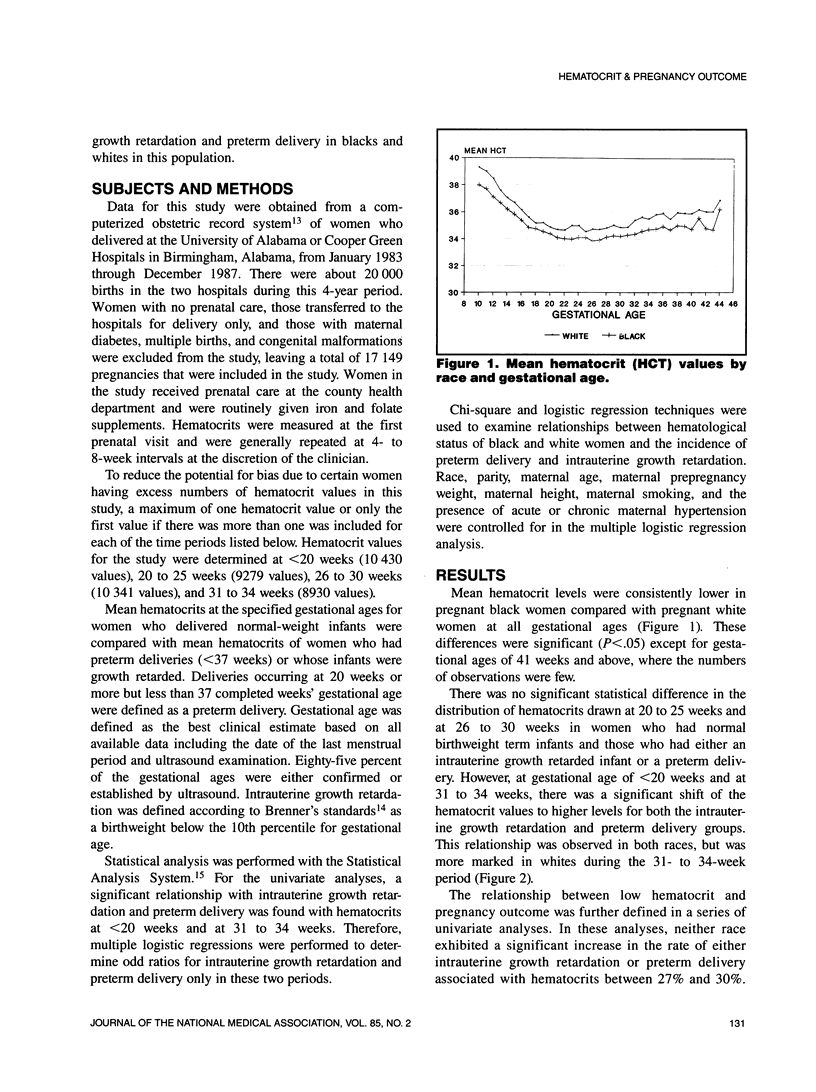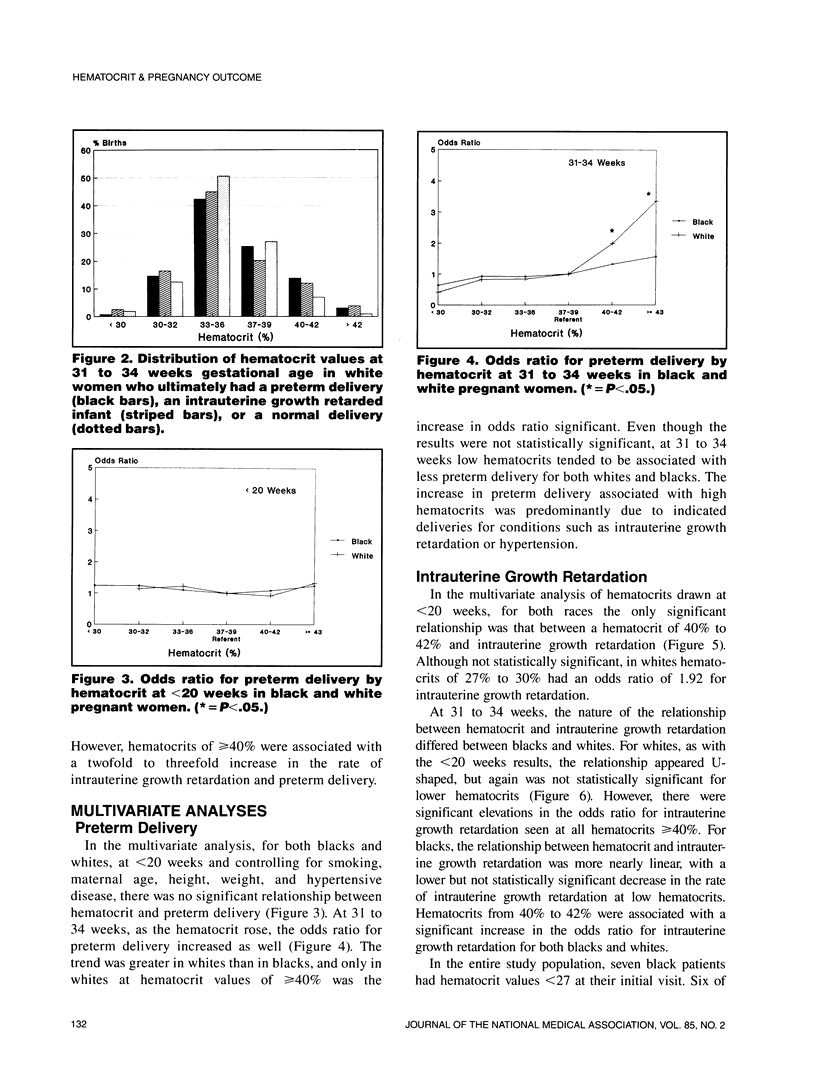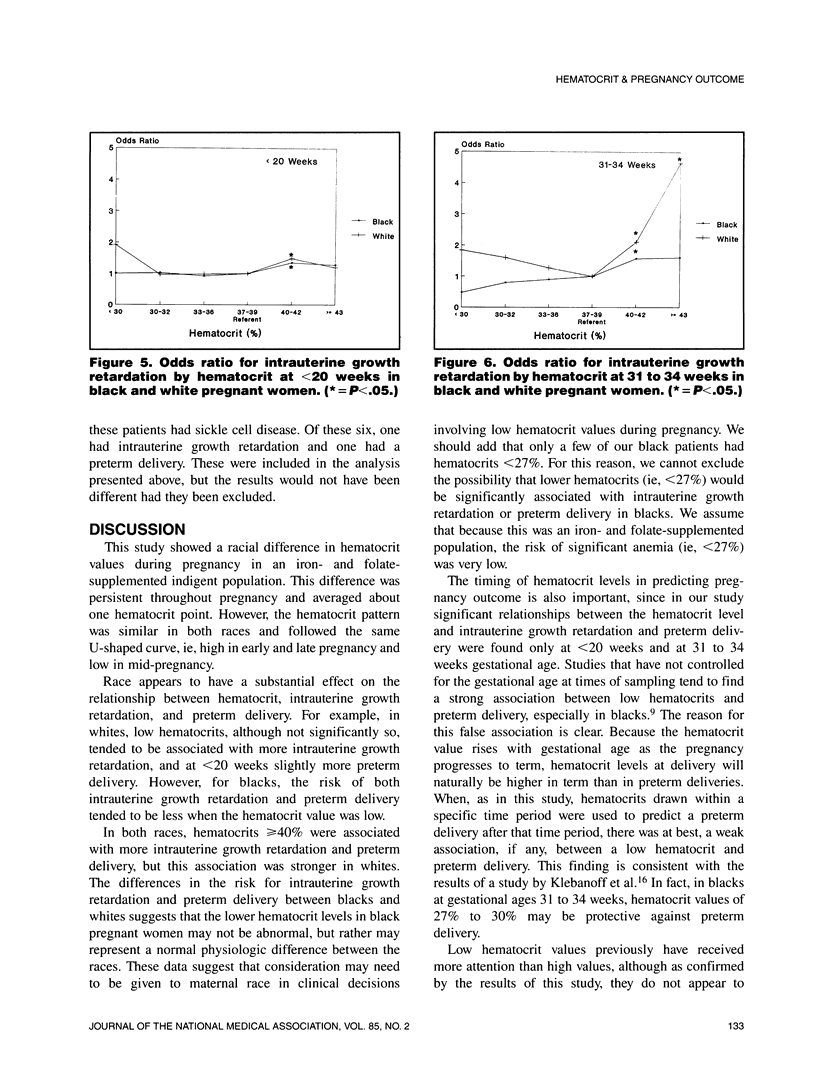Abstract
Racial differences in hematocrit levels and the relationship between low and high hematocrit, intrauterine growth retardation, and preterm delivery were studied in a population of 17,149 low-income, iron- and folate-supplemented pregnant women. Hematocrit levels drawn during four gestational periods were considered. Evaluating pregnancy outcome in regard to hematocrit values at specific gestational ages eliminated the bias resulting in the previously reported association between a low hematocrit and preterm delivery in blacks. In contrast, in this study, in blacks, hematocrits of 27% to 30% were associated with lower but not significant reductions in the rates of intrauterine growth retardation and preterm delivery. Our major finding was that at 31 to 34 weeks, hematocrits > or = 40% were associated with significantly higher odds ratios for intrauterine growth retardation for both blacks and whites. These findings should prompt more attention to women who have high hematocrits in pregnancy while reducing concern for women of either race with low hematocrits.
Full text
PDF




Selected References
These references are in PubMed. This may not be the complete list of references from this article.
- Brenner W. E., Edelman D. A., Hendricks C. H. A standard of fetal growth for the United States of America. Am J Obstet Gynecol. 1976 Nov 1;126(5):555–564. doi: 10.1016/0002-9378(76)90748-1. [DOI] [PubMed] [Google Scholar]
- Centers for Disease Control (CDC) CDC criteria for anemia in children and childbearing-aged women. MMWR Morb Mortal Wkly Rep. 1989 Jun 9;38(22):400–404. [PubMed] [Google Scholar]
- Garn S. M., Ridella S. A., Petzold A. S., Falkner F. Maternal hematologic levels and pregnancy outcomes. Semin Perinatol. 1981 Apr;5(2):155–162. [PubMed] [Google Scholar]
- Garn S. M., Smith N. J., Clark D. C. Lifelong differences in hemoglobin levels between Blacks and Whites. J Natl Med Assoc. 1975 Mar;67(2):91–96. [PMC free article] [PubMed] [Google Scholar]
- Goodlin R. C. The relationship between maternal hematocrit and pregnancy outcome. Obstet Gynecol. 1991 Jun;77(6):962–963. [PubMed] [Google Scholar]
- Klebanoff M. A., Shiono P. H., Berendes H. W., Rhoads G. G. Facts and artifacts about anemia and preterm delivery. JAMA. 1989 Jul 28;262(4):511–515. [PubMed] [Google Scholar]
- Koller O., Sandvei R., Sagen N. High hemoglobin levels during pregnancy and fetal risk. Int J Gynaecol Obstet. 1980 Jul-Aug;18(1):53–56. doi: 10.1002/j.1879-3479.1980.tb00241.x. [DOI] [PubMed] [Google Scholar]
- Lieberman E., Ryan K. J., Monson R. R., Schoenbaum S. C. Association of maternal hematocrit with premature labor. Am J Obstet Gynecol. 1988 Jul;159(1):107–114. doi: 10.1016/0002-9378(88)90502-9. [DOI] [PubMed] [Google Scholar]
- Murphy J. F., O'Riordan J., Newcombe R. G., Coles E. C., Pearson J. F. Relation of haemoglobin levels in first and second trimesters to outcome of pregnancy. Lancet. 1986 May 3;1(8488):992–995. doi: 10.1016/s0140-6736(86)91269-9. [DOI] [PubMed] [Google Scholar]
- Wirtschafter D. D., Blackwell W. C., Goldenberg R. L., Henderson S. A., Peake M. N., Huddleston J. F., Howell M. A county-wide obstetrical automated medical record system. J Med Syst. 1982 Jun;6(3):277–290. doi: 10.1007/BF00992804. [DOI] [PubMed] [Google Scholar]
- Yip R., Schwartz S., Deinard A. S. Hematocrit values in white, black, and American Indian children with comparable iron status. Evidence to support uniform diagnostic criteria for anemia among all races. Am J Dis Child. 1984 Sep;138(9):824–827. doi: 10.1001/archpedi.1984.02140470024008. [DOI] [PubMed] [Google Scholar]


